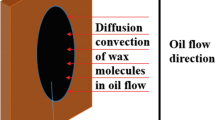With the increased exploitation of gas condensate resources, the problem of wax deposition in wellbores is increasingly severe. Hence, this paper reveals the co-deposition mechanism of vertical gas condensate wellbores with waxes, asphaltenes and scales from a microscopic viewpoint by molecular dynamics (MD) simulation techniques. Several experiments were also utilized to determine the basic physical properties of the condensate. To avoid inaccuracies caused by simplifying the condensate multiphase system using a single component, eight typical components were selected to enhance modelling precision according to actual well fluid characteristics. The wellbore, condensate, asphaltene and scale systems modelled by the MD simulation techniques were validated with the corresponding data from the National Institute of Standards and Technology (NIST), and this actual error of the results after stimulating was less than 10 %, which met the error criteria and verified the construction of the system model as realistic and feasible. The simulations investigate the co-deposition mechanism of waxes with asphaltenes and scales in vertical wellbores at three levels: diffusion mechanism, aggregation properties and co-deposition behavior. The simulation results show that as the waxy components in the models increases, the aggregated and adhered condensate layer at the wellbore becomes thinner and the “replacement” between the waxy components and condensate molecules begins happening, and this deposition phenomenon gradually strengthens. When in the asphaltene-condensate system, the promotion effect on the deposition of wax molecules becomes more obvious as these asphaltene components increases, but up to 2% asphaltene components, the wax deposition behavior is inhibited conversely. Simultaneously, asphaltenes with a larger variety and number of heteroatoms contribute more significantly to this co-deposition behavior of waxy components and asphaltene components. For these scale-condensate systems, the most prominent influence for the aggregation and deposition behavior of waxy components is exerted by sulphate scale, with the most noticeable co-deposition effect. Its interaction energy (absolute value) is the highest, reaching 3840 kJ/mol. The results in the article can offer a basis and instruction to this targeted management for wax deposits in vertical wellbores of gas condensate wells.




















Similar content being viewed by others
References
Z. Wang, Y. Liu, J. Li, X. Zhuge, and L. Zhang, “Study on two-phase oil-water gelling deposition behavior in low-temperature transportation,” Energy Fuels, 30(6), 4570-4582(2016).
Y. Liu, Z. Wang, X. Zhuge, S. Zhao, and R. Pang, “Study of deposition behavior in small-diameter gathering pipelines for water-cut oil,” Chem Tech Fuels Oil, 48(5), 386-392(2012).
B. Shi, Z. Wang, Z. Zhang, Y. Xu, and K. Ling, “A state of the art review on the wellbore blockage of condensate gas wells: Towards understanding the blockage type, mechanism, and treatment,” Lithosphere, 12, 2-18(2022).
G. Santos, N. Daraboina, and C. Sarica, “Dynamic microscopic study of wax deposition: Particulate deposition,” Energy Fuels, 35, 12065-12074(2021).
L. H. A. Mahir, C. Vilas Bôas Fávero, T. Ketjuntiwa, H. S. Fogler, and R. G. Larson, “Mechanism of wax deposition on cold surfaces: Gelation and deposit aging,” Energy Fuels, 33, 3776-3786(2019).
Y. Chi, N. Daraboina, and C. Sarica, “Effect of the flow field on the wax deposition and performance of wax inhibitors: Cold finger and flow loop testing,” Energy Fuels, 31, 4915-4924(2017).
J. J. Adams, F. Tort, J. F. Schabron, J. L. Loveridge, J. Rovani, and K. Baig, “Evaluation of wax inhibitor performance through various techniques,” Energy Fuels, 32, 12151-12165(2018).
Z. Wang, X. Liu, L. Li, J. Hong, Y. Qi, and X. Li, “Effect of a coated wall on wax-asphaltene molecule diffusion, aggregation, and adhesion mechanism: A molecular dynamics simulation study,” Energy Fuels, 36, 10191-10204(2022).
Y. Xu, H. Wang, Z. Wang, Z. Xu, J. Hong, and W. Sun, “Microscopic mechanism of asphaltene and resin behavior to the stability of oil-water interface” J. Northeast Pet. Univ., 45, 90-101(2021).
F. Yang, H. Zhu, C. Li, B. Yao, F. Wang, J. Chen, and G. Sun, “Investigation on the mechanism of wax deposition inhibition induced by asphaltenes and wax inhibitors,” J. Pet. Sci. Eng., 204, 108723(2021).
Z. Wang, Y. Xu, Y. Gan, X. Han, W. Liu, and H. Xin, “Micromechanism of partially hydrolyzed polyacrylamide molecule agglomeration morphology and its impact on the stability of crude oil-water interfacial film,” J. Pet. Sci. Eng., 214, 110492(2022).
G. Javanbakht, M. Sedghi, W. R.W. Welch, L. Goual, and M. P. Hoepfner, “Molecular polydispersity improves prediction of asphaltene aggregation,” J. Mol. Liq., 256, 382-394(2018).
Z. Wang, Y. Xu, N. Khan, C. Zhu, and Y. Gao, “Effects of the surfactant, Polymer, and crude oil properties on the formation and stabilization of oil-based foam liquid films: Insights from the microscale,” J. Mol. Liq., https://doi.org/10.1016/j.molliq.2022.121194(2022).
Y. Gan, Q. Cheng, Z. Wang, J. Yang, W. Sun, and Y. Liu, “Molecular dynamics simulation of the microscopic mechanisms of the dissolution, diffusion and aggregation processes for waxy crystals in crude oil mixtures,” J. Pet. Sci. Eng., 179, 56-69(2019).
C. Wu, J. Zhang, W. Li, and N. Wu, “Molecular dynamics simulation guiding the improvement of EVA-type pour point depressant,” Fuel, 84, 2039-2047(2005).
Acknowledgements
The authors gratefully acknowledge the approval and support from the Key Technologies R & D Program of PetroChina Tarim Oilfield Company.
Author information
Authors and Affiliations
Corresponding author
Additional information
Translated from Khimiya i Tekhnologiya Topliv i Masel, No. 1, pp. 66–74 January–February, 2023.
Rights and permissions
Springer Nature or its licensor (e.g. a society or other partner) holds exclusive rights to this article under a publishing agreement with the author(s) or other rightsholder(s); author self-archiving of the accepted manuscript version of this article is solely governed by the terms of such publishing agreement and applicable law.
About this article
Cite this article
Jing, H., Kong, C., Shen, J. et al. Co-Deposition Mechanism of Waxes with Asphaltenes and Scales in a Vertical Wellbore of Gas Condensate Well. Chem Technol Fuels Oils 59, 75–92 (2023). https://doi.org/10.1007/s10553-023-01506-8
Published:
Issue Date:
DOI: https://doi.org/10.1007/s10553-023-01506-8




